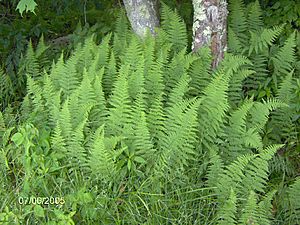Eastern hayscented fern facts for kids
Quick facts for kids Eastern hayscented fern |
|
|---|---|
 |
|
| Conservation status | |
| Scientific classification | |
| Genus: |
Dennstaedtia
|
| Species: |
punctilobula
|
The eastern hayscented fern, also known as the hay-scented fern, is a type of fern found in eastern North America. You can find it from Newfoundland in the east, all the way west to Wisconsin and Arkansas. It also grows south into the Appalachian Mountains, reaching northern Alabama. This fern is most common in the eastern parts of its range, with fewer plants found further west.
Contents
What is the Hay-Scented Fern?
The hay-scented fern is a special plant known for its unique smell. If you gently crush its leaves, it releases a fresh scent, just like newly cut hay! This is how it got its common name.
Appearance and Growth
This fern is a deciduous plant. This means that, like many trees, its leaves (called fronds) die back in the fall and grow new ones in the spring. Its fronds can grow quite tall, usually between 40 and 100 centimeters (about 1.3 to 3.3 feet) high, and sometimes even taller. They are about 10 to 30 centimeters (4 to 12 inches) wide.
The fronds have a detailed structure. They are "bipinnate," which means they are divided twice, like a feather within a feather. The smaller parts, called "pinnules," are about three times longer than they are wide.
Where Does It Grow?
You can find the hay-scented fern in many different places. It likes soils that are a bit damp or dry and are acidic. It often grows in forests or in open, sunny woodlands. It can live anywhere from sea level up to high altitudes of about 1,200 meters (nearly 4,000 feet).
How It Reacts to Light
The hay-scented fern can show something called phototropism. This is a fancy word for how plants grow or bend towards a light source. So, if there's more sunlight in one direction, the fern might lean that way to get more light!
The Hay-Scented Fern's Role in Nature
This fern plays an important part in the forests of the eastern United States. It can affect how other plants grow, especially young trees.
Ferns and Other Plants
In many forests, the hay-scented fern can become very common. When it grows in large patches, it can make it harder for new tree seedlings to sprout and grow tall. This is because the fern creates a thick layer on the forest floor, blocking sunlight and taking up space that young trees need.
Deer and the Forest
Animals like deer also play a role in how much hay-scented fern you see. Deer love to eat many plants, especially a type of berry bush called Rubus allegheniensis (a kind of blackberry). If there are a lot of deer, they might eat most of the Rubus plants.
The hay-scented fern, however, is not a favorite food for deer. So, if deer eat other plants, the hay-scented fern can spread and take over those areas. This can then limit the growth of new trees, changing the look of the forest floor.


